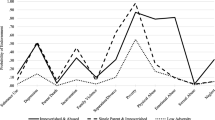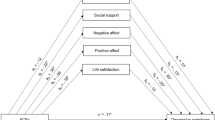Abstract
Contextual risk factors, such as adverse childhood experiences (ACEs), have a significant impact on the mental health of Black youth. Surprisingly, few studies focus efforts specifically on Black youth. The present study investigates the influence of ACEs on psychological distress among Black youth. Additionally, guided by social cognitive theory, this study highlights emotional self-control as a protective mechanism against the negative consequences of ACEs. Our findings show that ACEs (T1) predicted psychological distress among Black youth a year later (T2). Emotional self-control emerged as a significant buffer of ACEs on the association with psychological distress. Thus, to prevent negative mental health outcomes for Black youth, it is imperative to focus prevention efforts on the crucial risk factors that affect healthy development. By working to increase emotional self-control among Black youth who suffered adverse childhood experiences, negative mental health outcomes over time can be reduced.

Similar content being viewed by others
References
Baglivio, M. T., Wolff, K. T., Epps, N., & Nelson, R. (2017). Predicting adverse childhood experiences: The importance of neighborhood context in youth trauma among delinquent youth. Crime & Delinquency, 63(2), 166–188.
Bandura, A. (1991). Self-regulation of motivation through anticipatory and self-regulatory mechanisms. In R. A. Dienstbier (Ed.). Perspectives on motivation: Nebraska symposium on motivation (Vol. 38, pp. 69–164). University of Nebraska Press.
Bernstein, D. P., Fink, L., Handelsman, L., & Foote, J. (1994). Initial reliability and validity of a new retrospective measure of child abuse and neglect. The American Journal of Psychiatry, 151(8), 1132–1136.
Centers for Disease Control and Prevention (2019). Preventing Adverse Childhood Experiences: Leveraging the Best Available Evidence. Atlanta, GA: National Center for Injury Prevention and Control, Centers for Disease Control and Prevention. https://www.cdc.gov/violenceprevention/pdf/preventingACES.pdf.
Chapman, D. P., Whitfield, C. L., Felitti, V. J., Dube, S. R., Edwards, V. J., & Anda, R. F. (2004). Adverse childhood experiences and the risk of depressive disorders in adulthood. Journal of Affective Disorders, 82(2), 217–225. https://doi.org/10.1016/j.jad.2003.12.013.
Chatters, L. M., Nguyen, A. W., Taylor, R. J., & Hope, M. O. (2018). Church and family support networks and depressive symptoms among African americans: Findings from the National Survey of American Life. Journal of Community Psychology, 46(4), 403–417.
Dawson, J. F., & Richter, A. W. (2006). Probing three-way interactions in moderated multiple regression: Development and application of a slope difference test. Journal of Applied Psychology, 91(4), 917.
De Ridder, D. T., Lensvelt-Mulders, G., Finkenauer, C., Stok, F. M., & Baumeister, R. F. (2012). Taking stock of self-control: A meta-analysis of how trait self-control relates to a wide range of behaviors. Personality and Social Psychology Review, 16(1), 76–99.
DeLisi, M., Hochstetler, A., & Murphy, D. S. (2003). Self-control behind bars: A validation study of the Grasmick et al. scale. Justice Quarterly, 20(2), 241–263.
U.S. Department of Health & Human Services, Administration for Children and Families, Administration on Children, Youth and Families, Children’s Bureau (2017). Child Maltreatment 2015. Available from http://www.acf.hhs.gov/programs/cb/research-data-technology/statistics-research/child-maltreatment.
Douglas, K. R., Chan, G., Gelernter, J., Arias, A. J., Anton, R. F., Weiss, R. D., Brady, K., Poling, J., Farrer, L., & Kranzler, H. R. (2010). Adverse childhood events as risk factors for substance dependence: Partial mediation by mood and anxiety disorders. Addictive Behaviors, 35(1), 7–13. https://doi.org/10.1016/j.addbeh.2009.07.004.
Drake, B., Lee, S. M., & Jonson-Reid, M. (2009). ;2008;). Race and child maltreatment reporting: Are blacks overrepresented? Children and Youth Services Review, 31(3), 309–316. https://doi.org/10.1016/j.childyouth.2008.08.004.
Felitti, V. J., Anda, R. F., Nordenberg, D., Williamson, D. F., Spitz, A. M., Edwards, V., Koss, M. P., & Marks, J. S. (1998). Relationship of childhood abuse and household dysfunction to many of the leading causes of death in adults. The adverse childhood experiences (ACE) study. American Journal of Preventive Medicine, 14(4), 245–258. https://doi.org/10.1016/s0749-3797(98)00017-8.
Furukawa, T. A., Kessler, R. C., Slade, T., & Andrews, G. (2003). The performance of the K6 and K10 screening scales for psychological distress in the Australian National Survey of Mental Health and Well-Being. Psychological Medicine, 33(2), 357–362. https://doi.org/10.1017/s0033291702006700.
Grasmick, H. G., Tittle, C. R., Bursik, R. J. Jr., & Arneklev, B. J. (1993). Testing the core empirical implications of Gottfredson and Hirschi’s general theory of crime. Journal of Research in Crime and Delinquency, 30, 5–29.
Hicks, M. R., Kernsmith, P., & Smith-Darden, J. (2020). The effects of adverse childhood experiences on Internalizing and Externalizing behaviors among Black children and Youth. Journal of Child & Adolescent Trauma, 1–8.
Hilt, L. M., Leitzke, B. T., & Pollak, S. D. (2014). Cognitive control and rumination in youth: The importance of emotion. Journal of Experimental Psychopathology, 5(3), 302.
Jackson, J. S., Torres, M., Caldwell, C. H., Neighbors, H. W., Nesse, R. M., Taylor, R. J., Trierweiler, S. J., & Williams, D. R. (2004). The National Survey of American Life: A study of racial, ethnic, and cultural influences on mental disorders and mental health. International Journal of Methods in Psychiatric Research, 13(4), 196–207. https://doi.org/10.1002/mpr.177.
Kessler, R. C., Andrews, G., Hiripi, E., Mroczek, D. K., Normand, S. L. T., Walters, E. E., & Zaslavsky, A. M. (2002). Short screening scales to monitor population prevalences and trends in non-specific psychological distress. Psychological Medicine, 32, 959–976.
Li, S. T., Nussbaum, K. M., & Richards, M. H. (2007). Risk and protective factors for urban African American youth. American Journal of Community Psychology, 39(1/2), 21–35.
Liu, S. R., Kia-Keating, M., Nylund‐Gibson, K., & Barnett, M. L. (2020). Co‐occurring youth profiles of adverse childhood experiences and protective factors: Associations with health, resilience, and racial disparities. American Journal of Community Psychology, 65(1–2), 173–186.
Löfving-Gupta, S., Willebrand, M., Koposov, R., Blatný, M., Hrdlička, M., Schwab-Stone, M., & Ruchkin, V. (2017). Community violence exposure and substance use: Cross-cultural and gender perspectives. European Child & Adolescent Psychiatry, 27(4), 1–8.
Manyema, M., Norris, S. A., & Richter, L. M. (2018). Stress begets stress: The association of adverse childhood experiences with psychological distress in the presence of adult life stress. BMC Public Health, 18(1), 835.
Mersky, J. P., Topitzes, J., & Reynolds, A. J. (2013). Impacts of adverse childhood experiences on health, mental health, and substance use in early adulthood: A cohort study of an urban, minority sample in the US. Child Abuse & Neglect, 37(11), 917–925.
Molnar, B. E., Buka, S. L., & Kessler, R. C. (2001). Child sexual abuse and subsequent psychopathology: Results from the National Comorbidity Survey. American Journal of Public Health, 91(5), 753–760.
Mouzon, D. M., Taylor, R. J., Nguyen, A. W., & Chatters, L. M. (2016). Serious psychological distress among African americans: Findings from the National Survey of American Life. Journal of Community Psychology, 44(6), 765–780. https://doi.org/10.1002/jcop.21800.
Muthén, B. O., Muthén, L. K., & Asparouhov, T. (2017). Regression and mediation analysis using Mplus. Muthén & Muthén.
Penza, K. M., Heim, C., & Nemeroff, C. B. (2003). Neurobiological effects of childhood abuse: Implications for the pathophysiology of psychological distress and anxiety. Archives of Women’s Mental Health, 6(1), 15–22.
Pratt, T. C., & Cullen, F. T. (2000). The empirical status of Gottfredson and Hirschi’s general theory of crime: A meta-analysis. Criminology, 38(3), 931–964.
Sheidow, A. J., Henry, D. B., Tolan, P. H., & Strachan, M. K. (2013;2014;). The role of stress exposure and family functioning in internalizing outcomes of urban families. Journal of Child and Family Studies, 23(8), 1351–1365. https://doi.org/10.1007/s10826-013-9793-3.
Smith-Darden, J. P., Kernsmith, P. D., Reidy, D. E., & Cortina, K. S. (2017a). In search of modifiable risk and protective factors for teen dating violence. Journal of Research on Adolescence, 27(2): 423–435. https://doi.org/10.1111/jora.12280.
Smith-Darden, J. P., Kernsmith, P. D., Victor, B. G., & Lathrop, R. A. (2017b). Electronic displays of aggression in teen dating relationships: Does the social ecology matter? Computers in Human Behavior, (67): 22–40. https://doi.org/10.1016/j.chb.2016.10.015.
Straus, M. (1979). Measuring intrafamily conflict and violence: The conflict tactics (CT) Scales. Journal of Marriage and Family, 41(1), 75–88. https://doi.org/10.2307/351733.
Tice, D. M., & Bratslavsky, E. (2000). Giving in to feel good: The place of emotion regulation in the context of general self-control. Psychological Inquiry, 11(3), 149–159.
Tice, D. M., Bratslavsky, E., & Baumeister, R. F. (2018). Emotional distress regulation takes precedence over impulse control: If you feel bad, do it! In R. Baumeister (Ed.), Self-regulation and self-control (pp. 275–306). Routledge.
Tsuyuki, K., Al-Alusi, N. A., Campbell, J. C., Murry, D., Cimino, A. N., Servin, A. E., & Stockman, J. K. (2019). Adverse childhood experiences (ACEs) are associated with forced and very early sexual initiation among black women accessing publicly funded STD clinics in Baltimore, MD. PloS One, 14(5), e0216279.
Wade, J., Roy, Shea, J. A., Rubin, D., & Wood, J. (2014). Adverse childhood experiences of low-income urban youth. Pediatrics (Evanston), 134(1), e13–e20. https://doi.org/10.1542/peds.2013-2475.
Widom, C. S., DuMont, K., & Czaja, S. J. (2007). A prospective investigation of major depressive disorder and comorbidity in abused and neglected children grown up. Archives of General Psychiatry, 64(1), 49–56.
Williams, D. R., Gonzalez, H. M., Neighbors, H., Nesse, R., Abelson, J. M., Sweetman, J., & Jackson, J. S. (2007). Prevalence and distribution of major depressive disorder in African americans, Caribbean blacks, and non-hispanic whites: Results from the National Survey of American Life. Archives of General Psychiatry, 64(3), 305–315.
Womack, S. (2016). I know I can’t: The negative effects of post traumatic slave syndrome’s on the well-being of African American college students. The Vermont Connection, 37(1), 15.
Wyatt, G. E. (1985). The sexual abuse of afro-american and white-american women in childhood. Child Abuse & Neglect, 9(4), 507–519.
Author information
Authors and Affiliations
Corresponding author
Additional information
Publisher’s Note
Springer Nature remains neutral with regard to jurisdictional claims in published maps and institutional affiliations.
Rights and permissions
Springer Nature or its licensor (e.g. a society or other partner) holds exclusive rights to this article under a publishing agreement with the author(s) or other rightsholder(s); author self-archiving of the accepted manuscript version of this article is solely governed by the terms of such publishing agreement and applicable law.
About this article
Cite this article
Hicks, M.R., Smith-Darden, J., Johns, S. et al. Adverse Childhood Experiences Predicting Psychological Distress among Black Youth: Exploring Self-Control as a Moderator. Journ Child Adol Trauma (2024). https://doi.org/10.1007/s40653-024-00617-6
Accepted:
Published:
DOI: https://doi.org/10.1007/s40653-024-00617-6




